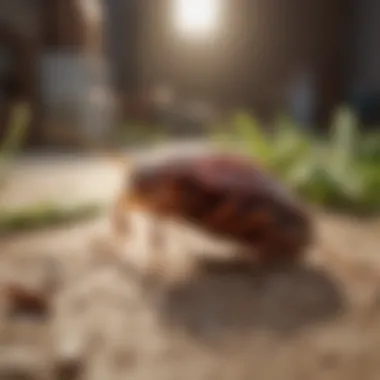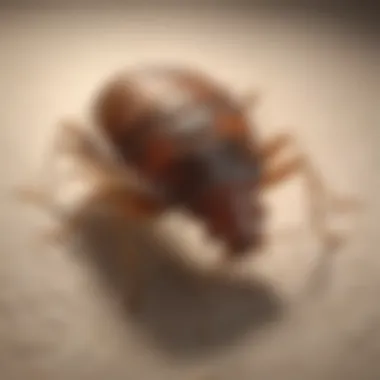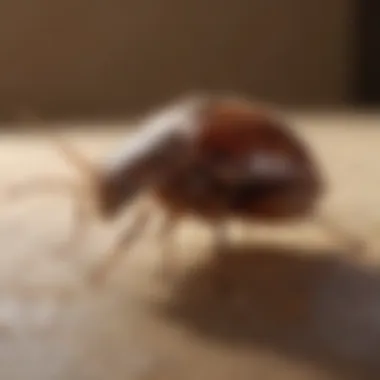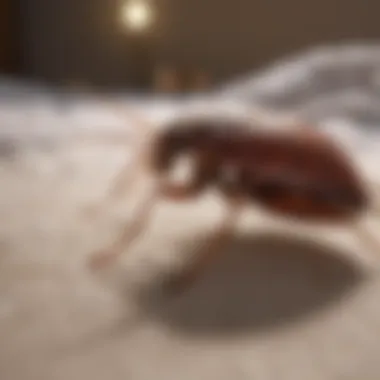Natural Strategies to Eliminate Bed Bugs Effectively


Intro
Bed bugs are small, blood-feeding insects that pose significant challenges for homeowners. Understanding how to identify and prevent these pests is essential for maintaining a healthy living environment. This section will discuss the biology of bed bugs and their typical behavior, providing a foundation for effective pest control.
Pest Identification
Common Household Pests
Bed bugs belong to the Cimex lectularius species. They are commonly found in beds, furniture, and other household items. Knowing the characteristics of bed bugs is critical. Adult bed bugs are reddish-brown, approximately 5-7 mm long, and have a flat, oval shape. They are not winged but move quickly, often hiding in crevices during the day. Understanding their appearance helps distinguish bed bugs from other pests like fleas or carpet beetles.
Signs of Infestation
Detecting a bed bug infestation early is crucial. Here are the main indicators:
- Bites: Bed bugs typically bite exposed skin, leading to itchy welts. Some people may not notice bites at first, complicating detection.
- Stains: Look for rust-colored spots on sheets or mattresses. These spots are often dried blood and feces.
- Eggs and Shells: Bed bug eggs are tiny and white, while shells are tan-colored and empty. Both can be found near hiding places.
- Odor: An infestation may produce a sweet, musty smell caused by their scent glands.
Identifying these indicators early can prevent further spread, making it easier to address an infestation.
Prevention Methods
Environmental Modifications
Prevention is often easier than treatment. Modifying the environment helps keep bed bugs at bay. Here are some effective strategies:
- Declutter: Reducing clutter removes hiding places that provide shelter for bed bugs.
- Seal Cracks: Use caulk to seal any cracks and crevices in walls, baseboards, and furniture. This makes it harder for bed bugs to enter.
- Use Protective Covers: Encasing mattresses and pillows in special bed bug-proof covers can prevent infestations from taking hold.
Home Maintenance Tips
Regular maintenance can go a long way in keeping bed bugs and other pests away:
- Wash Bedding: Wash all bedding and linens in hot water regularly. Heat kills bed bugs and their eggs effectively.
- Vacuum: Frequently vacuum carpets, rugs, and furniture. Dispose of the vacuum bag immediately to avoid reinfestation.
- Monitor Guests: Be cautious when bringing items into the home, especially second-hand furniture. Inspect thoroughly before use.
DIY Pest Control Solutions
Natural Remedies
Some natural remedies may deter bed bugs or help control their population:
- Diatomaceous Earth: This non-toxic powder can be sprinkled in areas where bed bugs hide. It dehydrates and kills them when they walk over it.
- Essential Oils: Oils such as tea tree or lavender may repel bed bugs. A spray mix can be made using diluted oils to treat affected areas.
DIY Traps and Barriers
Simple traps can be created to capture bed bugs:
- Sticky Traps: Place sticky traps around the bed legs to catch bed bugs as they move.
- Interceptors: These are devices placed under bed legs. They help catch bed bugs moving to and from the bed and provide a visual indicator of an infestation.
Effective pest management requires diligence and a systematic approach. Combining prevention methods and DIY solutions can significantly reduce the chances of encountering bed bugs.
By understanding the biological traits of bed bugs, preventive measures, and DIY solutions, homeowners can tackle infestations sustainably. These natural methods offer practical alternatives that contribute to healthier living spaces.
Prelude to Bed Bugs
Bed bugs are a persistent threat in households, and understanding them is crucial for effective control. This section introduces the topic and sets the stage for discussing natural methods of elimination.
The study of bed bugs includes their behavior, biology, and the indications that they have invaded a space. Recognizing these elements allows homeowners to respond quickly and effectively, minimizing the impact of an infestation.
Natural methods for dealing with bed bugs have gained traction as more people seek alternatives to chemical treatments, which can pose health risks and environmental concerns. Understanding bed bug biology is essential to grasping how these pests breed and spread. Additionally, knowing the signs of infestation can save time and resources.
By prioritizing natural methods, such as cleaning, heat treatments, and other sustainable practices, homeowners can address these pests without compromising their family’s health or the environment.


Understanding Bed Bug Biology
Bed bugs, scientifically known as Cimex lectularius, are small, flat, reddish-brown insects that feed on human blood. They thrive in warm, dark environments and are notoriously difficult to eradicate once established. Understanding their life cycle is key to managing infestations effectively.
Life Cycle Stages:
- Eggs: Tiny and white, these lay in clusters; one female can produce up to 500 eggs in her lifetime.
- Nymphs: Newly hatched bed bugs are almost transparent and require a blood meal to grow.
- Adults: Fully grown bed bugs can reach up to 5mm in length and are visible to the naked eye.
Knowing these stages helps homeowners target specific points in their life cycle for treatment.
Signs of Bed Bug Infestation
Detecting a bed bug infestation early is vital in mitigating its spread. Here are the common signs:
- Bite Marks: Red, itchy welts often appear in clusters or lines on the skin after feeding.
- Dark Spots: Small, dark fecal stains on bedding or furniture can indicate bed bug presence.
- Egg Cases: Shed skins and tiny, white eggs are common signs of an active infestation.
- Unusual Odors: A musty scent in the room is sometimes linked to bed bug activity.
It is essential to conduct regular inspections of sleeping areas for these signs. Early detection can lead to quicker resolution of the issue.
The Importance of Natural Methods
Natural methods for dealing with bed bugs hold significant value in contemporary pest management. As awareness grows regarding the harmful effects of chemical pesticides, many individuals seek home-based strategies that are both effective and safe. Natural methods often emphasize safety and sustainability, which are essential for long-term solutions against these resilient pests.
Adopting natural methods can lead to several benefits. First, they minimize risks associated with chemical exposure. Numerous common pesticides contain ingredients that can be harmful to humans and pets, particularly in enclosed spaces such as homes. Utilizing natural alternatives reduces the likelihood of allergic reactions or other health issues, making the home environment safer for everyone.
Additionally, these methods tend to be environmentally friendly. Traditional insecticides can have adverse effects on local ecology, contributing to pollution and harming beneficial insects. When pest control strategies prioritize the use of natural substances, they support environmental protection and biodiversity.
Furthermore, the cost-effectiveness of natural methods cannot be overstated. Many natural treatments can be prepared using household items or inexpensive ingredients. This aspect appeals to homeowners seeking budget-friendly solutions, allowing ordinary individuals to tackle infestations without needing to hire professionals or purchase expensive commercial products.
"Natural pest control methods not only protect your health but also contribute positively to the environment."
Health and Safety Considerations
When exploring ways to eliminate bed bugs naturally, health and safety should always be top priorities. Many household items used in natural treatments are safe for human contact and do not pose chemical hazards. For example, diatomaceous earth is non-toxic and acts as a physical barrier to bed bugs. Similarly, essential oils like tea tree and lavender oil not only repel insects but also have antimicrobial properties that benefit the household.
While many natural solutions are generally considered safe, it remains crucial to conduct thorough research and exercise care when applying these remedies. Some people may experience sensitivity to certain natural substances, including essential oils. It is advisable to do patch tests for any product used extensively throughout the home.
Using natural methods should not diminish the importance of thorough cleaning and meticulous inspection. These practices are essential for effective bed bug control, as an unclean environment could hinder the elimination process, regardless of the treatment employed.
Environmental Impact of Chemicals
The choice of employing natural methods drastically reduces the environmental impact associated with traditional chemical pest control. Chemical pesticides can lead to water contamination through runoff, adversely affecting waterways and surrounding ecosystems. The persistent use of such substances can contribute to pesticide resistance in pests, leading to a cycle of increased application and even more potent chemicals.
In contrast, natural solutions promote environmental sustainability. The ingredients found in many natural remedies break down more easily, resulting in less long-term pollution. By relying on non-chemical approaches, homeowners contribute to better air quality and encourage healthier surroundings for both people and wildlife.
Embracing natural methods allows for more balanced ecosystems. For instance, certain essential oils naturally repel bed bugs without harming other beneficial insects. Integrating chemical-free practices into pest management strategies aligns with a growing trend favoring environmentally-friendly living, which is valuable as awareness of ecological issues continues to rise.
In summary, understanding both health and environmental aspects underscores the significance of adopting natural methods for bed bug control. These strategies provide practical and sustainable solutions while mitigating potential risks to health and the environment.
Preparation for Treatment
Preparation is a crucial step in addressing a bed bug infestation. Without proper preparation, any treatment you employ may not have the desired outcome and could lead to further complications. By preparing effectively, you increase the chances of successfully getting rid of these pests while minimizing the risk of their return. Here are the two main components to focus on during this stage: identifying affected areas and cleaning and decluttering your living space.
Identifying Affected Areas
The first step in preparation involves identifying where bed bugs have infested your home. These pests tend to hide in specific locations, making it essential to conduct a thorough inspection. Common areas where bed bugs are found include:
- Mattresses and Box Springs: Check seams, folds, and crevices.
- Bed Frames: Inspect all parts of the bed, including headboards.
- Furniture: Look in and under sofas, chairs, and nightstands.
- Walls and Baseboards: Small cracks or gaps can serve as hiding spots.
- Luggage and Clothing: Bed bugs may hitch a ride on your items.
When inspecting, it is crucial to look for signs of infestation. This includes brown or red stains on bedding, tiny egg shells, or the bugs themselves, which are typically about the size of an apple seed.
Cleaning and Decluttering


Once you have identified affected areas, the next step is cleaning and decluttering your home. Reducing clutter will help expose hiding spots for bed bugs, allowing you to treat the infestation more effectively. Here are some practical steps you can take:
- Remove Clutter: Clear away any unnecessary items from floors and surfaces. This includes stacks of paper, clothes, and other belongings.
- Launder Bedding: Wash all bedding, curtains, and clothing in hot water and dry them on the highest heat setting. This will kill any bugs and their eggs.
- Vacuum Thoroughly: Use a vacuum cleaner to remove bed bugs and eggs from infected areas. Pay close attention to seams, corners, and under furniture.
- Seal Items: Place items that cannot be laundered in sealed bags for a few months. Bed bugs can survive without food for a long time, so this helps starve any potential survivors.
- Disinfect Surfaces: Follow up with a natural disinfectant to cleanse surfaces around the home where bed bugs may have traveled.
- Make sure to discard the vacuum bag immediately in a sealed plastic bag to prevent any escaped bugs.
"Effective cleaning is the groundwork for any successful treatment. Without it, the chances of complete elimination diminish."
In summary, thorough preparation is vital to the success of your bed bug treatment efforts. By accurately identifying affected areas and cleaning your home, you set a strong foundation for implementing natural treatments. This methodical approach will not only contribute to a successful resolution but will also help prevent future infestations.
Natural Bed Bug Treatments
Natural bed bug treatments are vital for effectively addressing bed bug infestations without relying on harsh chemicals. These methods often emphasize safety, both for humans and pets. Many homeowners prefer natural remedies to minimize health risks and environmental impact. This section highlights various natural treatments available, including their advantages and considerations.
Diatomaceous Earth
Diatomaceous earth is a widely recognized natural treatment for bed bugs. It is essentially a fine powder derived from fossilized aquatic organisms called diatoms. When sprinkled in areas where bed bugs are prevalent, it works by damaging their exoskeletons, causing them to dehydrate and die. One of the main advantages of diatomaceous earth is that it is non-toxic to humans and pets, making it a safe choice for households.
Its unique feature lies in its mechanical action rather than a chemical one. Bed bugs do not develop resistance to diatomaceous earth, unlike some pesticides. However, it requires careful application. Users must ensure it remains dry for maximum effectiveness, as moisture significantly reduces its potency.
Essential Oils
Essential oils are another popular choice in natural bed bug treatments. They possess various natural insecticidal properties and can repel or kill bed bugs directly.
Tea Tree Oil
Tea tree oil is highly regarded for its antimicrobial properties and insecticidal abilities. It disrupts the respiratory system of bed bugs upon contact, making it a beneficial choice for natural pest control. Its pleasant aroma also makes it favorable in household use. However, while effective, tea tree oil can cause irritation on sensitive skin, so it should be used with caution around pets and children.
Lavender Oil
Lavender oil is not only known for its calming scent but also as a deterrent for bed bugs. The strong fragrance of lavender can repel these pests, making it a preventive option. While it may not be as lethal as other treatments, its unique ability to offer a pleasant aroma while providing some protection makes it popular among homeowners. However, it must be noted that, like tea tree oil, its effectiveness is more in repelling rather than directly killing bed bugs.
Eucalyptus Oil
Eucalyptus oil is another effective essential oil with insect-repelling properties. Similar to lavender, its strong scent helps deter bed bugs from infesting areas where it is used. Eucalyptus oil can be mixed with a carrier oil or water before applying. It is important to mention that its strong aroma may not be appreciated by everyone and can cause irritation if used excessively.
Vinegar Solutions
Vinegar is often hailed as a common household product that can be used in multiple ways. It can also serve as a natural treatment for bed bugs. The acidic nature of vinegar can kill some insects upon direct contact. Spraying a vinegar solution on infested areas may lead to a reduction in bed bug populations. However, like essential oils, vinegar does not offer a lasting solution, as it does not kill the eggs. Regular application is necessary for tangible results, making it more of a supplementary method rather than a primary strategy.
Heat Treatments
Heat treatments are among the most effective natural methods for eliminating bed bugs. The goal is to raise the temperature in affected areas high enough to kill bed bugs and their eggs without causing harm to the environment or people.
Steam Cleaning
Steam cleaning involves utilizing a steam cleaner to apply high temperatures directly onto surfaces where bed bugs reside. Steam treatment is highly effective as it kills bugs and eggs on contact. It also sanitizes surfaces, making this method particularly appealing to homeowners. The main consideration is the need for precision during application, as improper use can leave areas untreated, allowing some bed bugs to survive.
Bedding in the Sun
Exposing bedding and linens to sunlight can also be a practical way to get rid of bed bugs. Direct sunlight raises the temperature of fabrics to levels that can kill bed bugs. This method is cost-effective and simple to implement. However, it requires sunny weather and can be time-consuming, as items must be left outside for an extended period.
Both steam cleaning and sun exposure provide effective heat treatments, making them worthwhile considerations for anyone struggling with an infestation.
Overall, employing a combination of these natural bed bug treatments can enhance your chances of eradicating these pests effectively while maintaining a healthy living environment.
Preventive Measures
Preventive measures play a crucial role in the management of bed bug infestations. Addressing these pests before they become a larger problem can save both time and resources. Implementing effective preventive strategies helps to reduce the likelihood of an infestation occurring, ensuring a healthier living environment. The benefits of these measures stretch beyond immediate pest control; they foster a more proactive approach toward household cleanliness and safety. Establishing a routine that includes inspections and cautious practices can significantly mitigate bed bug presence.
Regular Inspections


Regular inspections are key in early detection of bed bugs. Conducting these inspections on a consistent basis, especially in sleeping areas, can help identify signs of infestation before they escalate. Focus on areas where bed bugs are most commonly found, such as along mattress seams, behind headboards, and in any cracks or crevices around furniture.
To conduct an effective inspection, follow these steps:
- Remove bedding: Strip the bed and inspect sheets and blankets for small, rust-colored stains, which may be signs of bed bug excrement.
- Check the mattress and box springs: Look closely along seams, corners, and underside for live bugs or their eggs.
- Examine furniture: Investigate upholstered items and any gaps in wooden furniture, as bed bugs can hide in these environments.
- Inspect electrical outlets: Bed bugs can inhabit the areas near electrical outlets or wall sockets. Be cautious and thorough in these areas.
By regularly inspecting these high-risk sites, you can significantly reduce the chance of a full-blown infestation and maintain a more comfortable home.
Protective Bed Covers
Using protective bed covers is another effective preventive measure against bed bugs. These covers serve as a physical barrier between you and the bed bugs, inhibiting their access to your mattress and pillows. It's essential to choose high-quality, zippered encasements specifically designed for bed bug protection.
Benefits of employing protective bed covers include:
- Barrier against bites: These covers can protect you from bites while you sleep, providing peace of mind.
- Preventing infestations: They effectively trap any existing bed bugs within the mattress, preventing them from escaping and spreading.
- Ease of maintenance: Protective covers can usually be washed and maintained easily, contributing to overall hygiene.
Ensure the bed cover is fully sealed and check regularly for any signs of wear or damage. Bed bug protection should be part of a broader strategy that includes thorough cleaning and regular inspections.
Regular vigilance and preventive actions can significantly impact your home environment, making it less susceptible to bed bugs.
Implementing these preventive measures lays a strong foundation for controlling bed bug populations before they can multiply, leading to a sustainable solution in managing these pests.
Monitoring and Follow-Up
Monitoring and follow-up are critical components in managing a bed bug infestation. Even after applying natural treatments, it is important to keep an eye on the situation. These steps ensure that the bed bugs do not return and that the methods you employed were effective.
Regular Assessments: Establish a routine to assess the areas where you previously noticed signs of bed bugs. This could mean checking mattresses, bed frames, and nearby furniture. Look for any indications such as live bugs, shed skins, and eggs.
Regular monitoring helps to catch any potential re-infestation early, making control efforts more manageable.
Documentation: Keep a record of what you observe during each inspection. Note the date, time, and any signs you see. This can provide insights into when and how the infestation developed. Such information can be invaluable should you need to seek professional help later.
Utilizing Traps: Basic traps can be set up to monitor activity. Consider placing sticky traps near bed legs or in dark corners. These devices can capture any wandering bed bugs, enabling early detection.
Signs of Treatment Success
Recognizing the signs that indicate your treatment has been successful can offer needed peace of mind. Firstly, a reduction in the frequency of bites is often a strong indicator. Many homeowners report that they experience fewer bites after they have treated their homes.
Additionally, you may notice less increased bed bug activity. If you had a significant number of visible bugs prior to treatment, an overall decrease would signify that the methods used are working. It's advisable to thoroughly check traps set for any capture, as this can also reflect the effectiveness. Overall, if the signs of infestation subside, this is a good indication of success.
When to Seek Professional Help
In some instances, home treatment might not be effective, and it is necessary to call for professional pest control. If the infestation persists despite your diligent efforts, it may be time for experts to step in.
Professional services can utilize a wider range of treatment methods and have access to advanced tools. If you notice large populations of bed bugs remaining post-treatment, do not hesitate to contact a professional. Additionally, if you feel overwhelmed or lack the time to continue treating the infestation, it is best to reach out for help.
Finally, a persistent presence of bed bug bites or new signs of activity could indicate that the problem is more extensive than initially perceived. Seeking professional advice at this stage is a prudent choice to ensure your living space remains bed bug free.
Finale
In summary, this article emphasizes the significance of natural methods in addressing bed bug infestations. Understanding the biology of bed bugs and recognizing the signs of their presence are essential first steps. It is vital to utilize strategies that not only eliminate the bugs but also ensure ongoing prevention.
Recap of Natural Strategies
The natural strategies discussed include:
- Diatomaceous Earth: A non-toxic powder that dehydrates bed bugs on contact.
- Essential Oils: Natural oils like tea tree, lavender, and eucalyptus can repel and kill these pests due to their strong scents and properties.
- Vinegar Solutions: Vinegar acts as a deterrent and can be used for direct application on contact.
- Heat Treatments: High temperatures from steam cleaning or sun exposure can effectively kill bed bugs at all life stages.
In addition to treatment methods, preventive measures such as regular inspections and protective bed covers are crucial. These measures help maintain a bed bug-free environment, which is significantly less stressful for household members.
Encouragement for Sustainable Practices
Adopting sustainable practices in pest control not only benefits your home but also the environment. Using natural methods reduces reliance on harsh chemicals, minimizing exposure to harmful substances. Sustainable practices promote a healthier living space and contribute to long-term pest management.
It is important to remain vigilant and proactive. Regularly inspect your living areas and employ the techniques discussed to combat any potential infestation.
Taking these natural, sustainable approaches empowers homeowners to manage bed bug concerns effectively. You will find that embracing these methods yields peace of mind and a healthier home.















